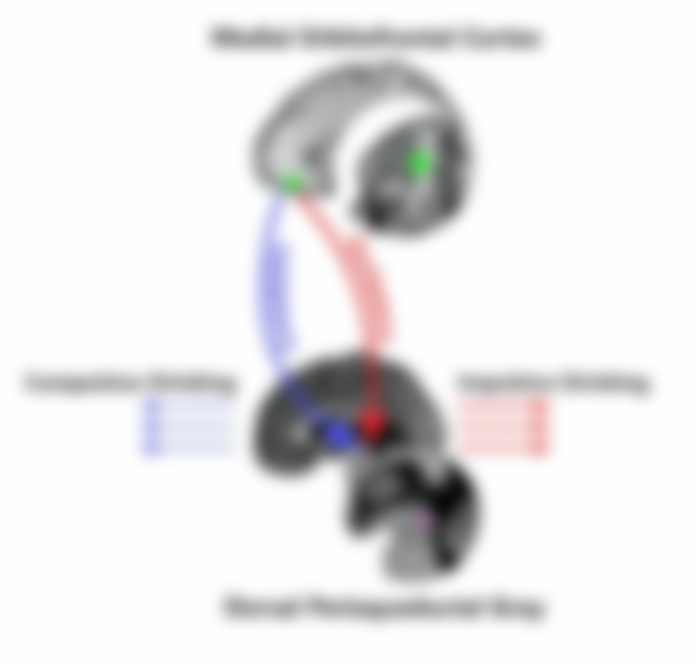
Dependence on addictive substances is a major health problem. Understanding the triggering factors and the neurological mechanisms at play is therefore crucial in the fight against substance abuse and offering appropriate withdrawal therapies. One of the most common and devastating forms of addiction is alcoholism - 45,000 deaths per year result from it in France alone. Recently, British and Chinese researchers have located its potential physical origin in a specific network of neurons, which notably regulates our reaction to danger
The median orbitofrontal cortex (mOFC), located at the front of the brain, is responsible for detecting unpleasant or emergency situations, then sends this information to the dorsal periaqueductal gray matter (dPAG), located in the center of the brain - in fact. , it is a set of neurons (forming a mass of gray matter, hence its name).
The latter makes it possible to decide whether or not a situation should be avoided. According to the results of the new study, it is also responsible, via a complex mechanism, for the “impulsive and compulsive” consumption of alcohol in many individuals. The research was carried out as part of an international collaboration, co-led by Dr Tianye Jia of Fudan University, Professor Jianfeng Feng of the University of Warwick and Fudan University, and Professor Trevor Robbins of Cambridge University and Fudan University. The details were published in the journal Science Advances.
A bifactorial imbalance
According to researchers, a person is at higher risk of developing alcohol use disorders when this information channel is out of balance in two ways:
Alcohol inhibits dPAG (the area of the brain that deals with adverse situations), so the brain cannot respond to negative signals or the need to escape danger, leading an individual to only feel the benefits of alcohol consumption, not its bad side effects. It is a possible cause of compulsive alcohol consumption.
A person suffering from an alcohol addiction will also usually have an overexcited pAG, making them feel that they are in an unfavorable or unpleasant situation from which they wish to escape, and they will turn "urgently" to the. alcohol to do it. It is the cause of impulsive alcohol consumption.
I was asked to comment on an earlier study in mice with a similar purpose: to locate possible origins of alcohol abuse. It is exciting to be able to replicate these mouse models in humans and, of course, to go further to identify a dual pathway model that links alcohol abuse with a tendency to exhibit impulsive behavior , ”says the Professor Jianfeng Feng, Computer Science Department, University of Warwick.

Sectional view of the median orbitofrontal cortex. The downregulation of dorsal periaqueductal gray matter (dPAG, stands for Dorsal Periaqueductal Gray) is linked to impulsive and compulsive alcohol consumption. © University of Warwick
" It is remarkable that these neural systems in mice, which deal with responding to threats and 'punishments', have been shown to be relevant to our understanding of the factors leading to alcohol abuse in adolescents, " says the Professor Trevor Robbins, Department of Psychology, University of Cambridge. “ We found that the same top-down neural regulation could malfunction in two completely different ways, while leading to similar alcohol abuse behavior ,” says Dr. Tianye Jia, of the Institute of Science and Technology. Fudan University.
Before considering their study in humans, the research team had noticed that previous rodent models showed that the brain areas mPFC and dPAG could be at the origin of precursors of alcohol dependence. They then analyzed MRI brain scans from the IMAGEN dataset - a group of 2,000 people from the UK, Germany, France and Ireland who are engaged in scientific research to advance knowledge on how whose biological, psychological and environmental factors during adolescence can influence brain development and mental health.
Participants undertook task-based functional MRI scans, and when they were not rewarded in the tasks (which produced negative feelings of punishment), the regulation between mOFC and dPAG was more strongly inhibited in participants who had demonstrated alcohol abuse. Likewise, at rest, participants who showed a more "over-excited" regulatory pathway between mOFC and dPAG (leading to feelings of urgent need to escape a situation) also had increased levels of dPAG. alcohol abuse.
Alcoholism is one of the most common and devastating addictions. According to a WHO report published in 2018, more than 3 million deaths per year are linked to alcohol consumption worldwide (45,000 in France), and harmful alcohol consumption contributes to 5.1 % of the global disease burden. Understanding the triggers and the neurological mechanisms involved is therefore crucial to better help these people and to offer adapted withdrawal therapies.


Nice